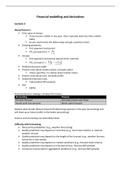Financial modelling and derivatives
Lecture 1
Recap finance 1:
• Time value of money
▪ If you receive a dollar in one year, that is typically word less than a dollar
today
▪ As you could invest the dollar today and get a positive return
• Growing perpetuity
▪ First payment next period
𝐶1
▪ 𝑃𝑉0 (𝑝𝑒𝑟𝑝𝑒𝑡𝑢𝑖𝑡𝑦 ) = 𝑟−𝑔
• Annuity
▪ First payment next period, payments for t periods
𝐶 1
▪ 𝑃𝑉0 (𝑎𝑛𝑛𝑢𝑖𝑡𝑦) = 1 [1 − 𝑡]
𝑟 (1+𝑟)
• Dividend discount model
• Finance cares about market values, not book values
▪ Unless specified, it is always about market values
• Finance cares about cash, not book profits
• Investment decision rules
▪ Take positive NPV projects
• Also
▪ CAPM
Financial decision making is all about the future
Accounting Finance
Records the past Estimates future cash flows
Works with real amounts Works with forecasts
Market value brands (finance) based off advertising expenses in the past (accounting) and
will show up as future profits in the books (accounting)
Finance and accounting are inexorably linked
Difficulty with forecasting
• Necessarily probabilistic (e.g., weather forecasting)
• Quality prediction may depend on incentives (e.g., local news stations vs national
weather service)
• Quality prediction may depend on the length of the forecast (e.g., weather forecast
tomorrow vs two weeks)
• Quality prediction may depend on market sentiment (e.g., forecast stock returns)
• Quality prediction may depend on time period (e.g., forecast GDP growth)
• Consensus may be bad for aggregation predictions (e.g., forecast GDP growth)
,Two common problems in economic forecasting
So, forecasting is hard, and it involves risk
Lecture 2 – Asset returns and volatility portfolios
Risk and return
• Insights from 90+ years of investor history
• Small stocks had the highest long-term returns, while Treasury-bills had the lowest
long-term returns
• Small stocks had the largest fluctuations in price, while Treasury-bills had the lowest
fluctuations
▪ Higher risk requires a higher return
• If you have a longer investment horizon, typically it makes more sense to invest in
more risky assets
▪ As risk typically evens out over a long time period
Asset returns
• Realized returns
▪ The return that actually occurs over a particular time period
𝐷𝑖𝑣𝑡+1 +𝑃𝑡+1 𝐷𝑖𝑣𝑡+1 𝑃𝑡+1 −𝑃𝑡
▪ 𝑅𝑡+1 = −1= + Capital gains
𝑃𝑡 𝑃𝑡 𝑃𝑡
▪ In other words
Dividend yield
o Return = dividend yield + capital gain rate
Common measure of risk and return
• Asset returns as random variables:
▪ Probability distributions
, o When an investment is risky, it may earn different returns. Each
possible return has some likelihood of occurring. We can summarize
this information with a probability distribution, which assigns a
probability, 𝑃𝑅 , that each possible return, R, will occur.
▪ Expected returns
▪ Variance, volatility (risk)
o Volatility = standard deviation
▪ Higher moments (skewness, kurtosis)
Expected return
• Expected (mean) return
▪ Calculated as a weighted average of the possible returns, where the weights
correspond to the probabilities
▪ Expected return = 𝐸[𝑅] = ∑𝑅 𝑃𝑅 ∗ 𝑅
Variance and standard deviation
• Variance
▪ The expected squared deviation from the mean
▪ 𝑉𝑎𝑟(𝑅) = 𝐸[(𝑅 − 𝐸[𝑅])2 ] = ∑𝑅 𝑃𝑅 ∗ (𝑅 − 𝐸[𝑅])2
• Standard deviation
▪ The square root of the variance
▪ 𝑆𝐷(𝑅) = √𝑉𝑎𝑟(𝑅)
▪ In finance, the standard deviation of a return is also referred to as its
volatility. The standard deviation is easier to interpret because it is in the
same units as the returns themselves.
Volatility – standard deviation of returns
• Volatility is mostly measured in % per annum
• It is a measure of uncertainty about asset returns
• Scaling with different horizons:
▪ 𝜎𝑇 𝑝𝑒𝑟𝑖𝑜𝑑𝑠 = 𝜎1 𝑝𝑒𝑟𝑖𝑜𝑑 ∗ √𝑇
• From daily to annually:
▪ 𝜎𝑑𝑎𝑖𝑙𝑦 ∗ √252
o T = 252, as there are on average 252 trading days per year
• Similarly:
▪ 𝜎𝑎𝑛𝑛𝑢𝑎𝑙 = 𝜎𝑚𝑜𝑛𝑡ℎ𝑙𝑦 ∗ √12
▪ 𝜎𝑎𝑛𝑛𝑢𝑎𝑙 = 𝜎𝑤𝑒𝑒𝑘𝑙𝑦 ∗ √52
Historic returns and volatility
Average annual return
1 1
• 𝑅̅ = (𝑅1 + 𝑅2 + ⋯ + 𝑅𝑇 ) = ∑𝑇𝑡=1 𝑅𝑡
𝑇 𝑇
, ▪ Where 𝑅𝑡 is the realized return of a security in year t, for the years 1 through
T
The variance and volatility of returns
• Variance estimates using realized returns
1
▪ 𝑉𝑎𝑟(𝑅) = 𝑇−1 ∑𝑇𝑡=1(𝑅𝑡 − 𝑅̅)2
▪ The estimate of the standard deviation is the square root of the variance
• Standard deviation
▪ 𝜎(𝑅) = √𝑉𝑎𝑟(𝑅)
Estimation error – using past returns to predict the future
• We can use a security’s historical average return to estimate its actual expected
return. However, the average return is just an estimate of the expected return.
• Standard error
▪ A statistical measure of the degree of estimation error
𝑆𝐷(𝑅)
▪ 𝑆𝐸 =
√𝑇
• 95% confidence interval is approximately:
▪ Confidence interval = historical average return +1.96 * standard error
▪ Of course, be careful when estimating with only a couple of years of data!
Portfolios
The expected return of a portfolio
• Portfolio weights
▪ The fraction of the total investment in the portfolio held in each individual
investment in the portfolio
▪ The portfolio weights must add up to 1.00 or 100%
𝑉𝑎𝑙𝑢𝑒 𝑜𝑓 𝑖𝑛𝑣𝑒𝑠𝑡𝑚𝑒𝑛𝑡 𝑖
▪ 𝑥𝑖 = 𝑇𝑜𝑡𝑎𝑙 𝑣𝑎𝑙𝑢𝑒 𝑜𝑓 𝑝𝑜𝑟𝑡𝑓𝑜𝑙𝑖𝑜
• Then the return on the portfolio, 𝑅𝑃 , is the weighted average of the returns on the
investments in the portfolio, where the weights correspond to portfolio weights.
▪ 𝑅𝑃 = 𝑥1𝑅1 + 𝑥2 𝑅2 + ⋯ + 𝑥𝑛 𝑅𝑛 = ∑𝑖 𝑥𝑖 𝑅𝑖
• The expected return of a portfolio is the weighted average of the expected returns of
the investments within it.
▪ 𝐸[𝑅𝑃 ] = 𝐸[∑𝑖 𝑥𝑖 𝑅𝑖 ] = ∑𝑖 𝐸[𝑥𝑖 𝑅𝑖 ] = ∑𝑖 𝑥𝑖 𝐸[𝑅𝑖 ]
Diversification
Diversify your investments






